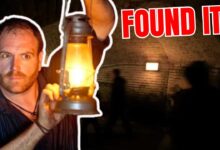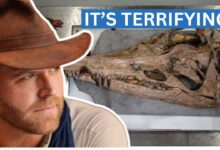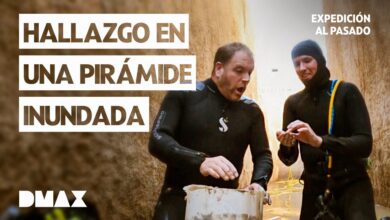Telescope Creates an Artificial Star With Lasers | Expedition Unknown: Hunt for Extraterrestrials
Telescope Creates an Artificial Star With Lasers | Expedition Unknown: Hunt for Extraterrestrials

Fortunately, there is one place for me to stop.
It’s been called the Stargazers Oasis.
Its real name is the ESO Hotel.
[Music]
It may well be the most exclusive accommodations in the world.
Hello, checking in. Can I see your ID, please?
Sure.
And your PhD?
Say what now?
This hotel is not open to the general public.
The only people permitted to stay here are elite astronomers.
And in case you’re wondering if this place looks familiar, that’s probably because James Bond blew it to smithereens in Quantum of Solace.
But since they don’t serve booze at this altitude, I won’t be able to enjoy Bond’s signature martini.
Orange soda, shaken, not stirred.
That’s a terrible Sean Connery.
So why put a resort for astronomers in the middle of the desert?
Because this is next door.
This is the Paranal Observatory, the largest visible light telescope in the world.
It’s over 8,000 feet up, and since the closest city is two hours in any direction, there’s nearly zero light pollution.
This past February, the scientists at Paranal helped confirm the discovery of a grouping of planets in the TRAPPIST-1 system.
But the reason they made international headlines is that they just might be able to support life.
To learn about this sensational discovery, I’m meeting with astronomer Julian Girard.
Julian, hey, how are you?
Oh, you, Josh! Nice to meet you.
Nice to meet you, too.
This is extraordinary! Yeah, tell me about this.
This is obviously a telescope facility.
Yeah, the whole thing is called a Very Large Telescope.
It’s called the Very Large Telescope.
Very large telescope.
How did you come up with that?
Uh, I mean, you know, European astronomers like these titles, right? It’s very to the point.
Optical telescopes, like the ones here, are basically huge souped-up versions of the little one which I used to look at the moon in my backyard.
Lenses and mirrors focus light from the stars for us to see.
Your organization was a part of a major discovery recently.
Yeah, so there was this, uh, this system with seven exoplanets.
Three of them are probably in what we call the habitable zone, where you could find liquid water.
Right, so this is like the Goldilocks zone.
Right, if you’re too close to the sun, the planet’s too hot; if you’re too far away, it turns out you’re in this…
[Music]
Are planets available each star? You can actually see at naked eye.
So how many stars are in our galaxy?
So our galaxy has between 200 and 400 billion stars.
And how many galaxies are there?
Billions and billions.
And so the total number of stars is…
I cannot say the number of zeros. Like 24 zeros, maybe.
Right, so right now, there could be another TV host interviewing another astronomer on another planet, talking about this planet.
Yeah, it’s possible. But are they as handsome?
Really?
Yeah, I don’t know how many arms they have or eyes or whatever.
Is it possible to see how these things work?
Yeah, sure. Be my guest.
The action starts around here when it gets dark. So before the sun drops, Julian takes me for a walk around the complex.
As we enter one of the four massive buildings that house the lenses for the VLT, I instantly redefine my concept of very large.
Oh my god!
[Music]
Look at this thing!
So here, you see this whole thing that is…
It’s like 400 tons.
This is insane. This is for sure the single most complex piece of equipment I have ever seen.
[Music]
As the sun begins to set, the scientists here jump into action to prepare for the night’s stargazing.
Julian shows me some of the images the VLT has recently captured, including a close-up on a star that’s basically saying cheese.
So that’s the star in real time?
Yes. And how far away is that?
So this star is 160 parsecs.
Yeah, so it’s like 13 times the Kessel Run.
Exactly, yeah.
It just so happens that I’ve arrived in time to witness a major test.
This telescope has four very powerful lasers and…
They excite sodium atoms in the atmosphere, basically to create an artificial star.
That’s a reference that helps the adaptive optic system to sharpen the images despite the atmosphere.
So you’re going to create an artificial star to be more in focus on other objects?
Exactly. The light coming from deep space has to pass through the turbulence and pollution of Earth’s atmosphere.
The lasers can create an artificial star at the edge of space, which the telescope can focus on, cancel out the interference, and get a crystal-clear look at distant stars.
Uh-huh.
Okay, so this is the test?
Yeah, yeah. Is this the gentleman running the test?
Yeah.
Hello. Hi.
Okay, I see you have a helmet and protective eyewear on.
Is this going to work?
Hopefully.
Hopefully.
Okay.
Let’s fire it up!
These aren’t the lasers you find at rock concerts and nightclubs.
And if they malfunction, they could blow this mountaintop up like the Death Star.
[Music]
Massive doors open. The system buzzes to life, and I have no idea what to expect.
[Music]
Then, it’s show time.
[Music]
[Applause]
[Music]
The eyes working.
It works! Yes, it works! Perfect.
Nice work. Nice.
We just destroyed Alderaan.
There’s a new star in the sky: an artificial one.
The laser’s humming properly, and the telescope is able to go to work for the night.
I have no doubt you’re going to be finding many more exoplanets.
Yes, that’s for sure.
Alright, well, keep us posted. Their telescope may be a little bigger than mine at home, and their backyard is a lot darker. But in all the important ways, I know how Julian and his team feel.
This is a place of curiosity, of anticipation, and of discovery.
I can’t wait to see what they find next.
Thanks so much for letting us know. I really appreciate it. This was really cool.
Make sure to get some sleep once in a while.
I need it.
You.








